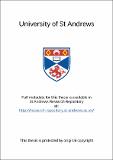Files in this item
Development and application of telemetry techniques to investigate seal behaviour and survival
Item metadata
| dc.contributor.author | McConnell, Bernie | en |
| dc.coverage.spatial | 1 v. (various pagings) : ill., maps 30 cm. | en |
| dc.date.accessioned | 2021-04-08T08:59:26Z | |
| dc.date.available | 2021-04-08T08:59:26Z | |
| dc.date.issued | 2004 | |
| dc.identifier.uri | https://hdl.handle.net/10023/21922 | |
| dc.description.abstract | The work described in this thesis covers the development and application of telemetry techniques to investigate seal behaviour and survival. The accuracy of animal location fixes derived from the Argos satellite system was determined, and filtering methods were constructed which removed the more erroneous locations fixes. We developed Argos Satellite Relay Data Loggers (SRDLs) which collect and relay dive and behavioural information from marine mammals via the Argos satellite system. SRDLs were used to describe the foraging and dive behaviour of adult South Georgia southern elephant seals (Miroimga leonina) in relation to bathymetric and oceanographic features. SRDLs were also deployed on naive southern elephant seal pups at Macquarie Island to determine the patterns of dispersal and to relate these patterns to oceanographic variability. Body condition measures and energy expenditure estimates suggested that the smaller weaned pups were almost at the stage of starvation before they encountered foraging areas. UK Grey seal (Halichoerus grypus) foraging was also studied using SRDLs. Most patterns of movement were within 40 km of haulout sites and foraging was inferred to take place in localised areas that were often the preferred habitat of sandeels (.Ammodytes spp). Grey seals could also move many hundreds of kilometres from one region to another. Factors that influence the first year survivouship of grey seal pups were studied in a markrecapture experiment at the Isle of May (UK). Survivourship was greater for females and for those weaned pups with a greater weaned body mass. Also higher postweaning circulating levels of immunoglobulin decreased the probability of survival. A novel telemetry mark-recapture technique based on mobile phone technology was developed to collect 'resighting' data more efficiently and from which survivorship could be modelled with fewer assumptions. | en |
| dc.language.iso | en | en |
| dc.publisher | University of St Andrews | en |
| dc.subject.lcc | QL737.P64M37 | |
| dc.subject.lcsh | Seals (Animals)--Behavior | en |
| dc.subject.lcsh | Biotelemetry | en |
| dc.title | Development and application of telemetry techniques to investigate seal behaviour and survival | en |
| dc.type | Thesis | en |
| dc.type.qualificationlevel | Doctoral | en |
| dc.type.qualificationname | PhD Doctor of Philosopy | en |
| dc.publisher.institution | The University of St Andrews | en |
This item appears in the following Collection(s)
Items in the St Andrews Research Repository are protected by copyright, with all rights reserved, unless otherwise indicated.

